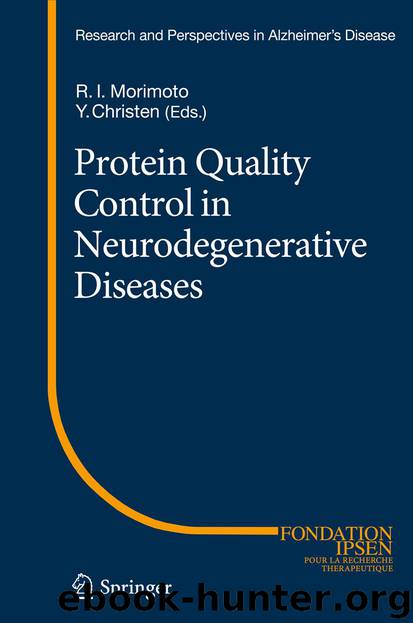Protein Quality Control in Neurodegenerative Diseases by Richard I. Morimoto & Yves Christen

Author:Richard I. Morimoto & Yves Christen
Language: eng
Format: epub
Publisher: Springer Berlin Heidelberg, Berlin, Heidelberg
Autophagy in the fight against proteotoxicity
Early reports regarding the ability of macroautophagy to degrade proteins when present as irreversible oligomeric complexes or as aggregates inside cells generated a considerable level of excitement in fields such as neurodegeneration (Ravikumar et al. 2002). Macroautophagy revealed itself as an efficient mechanism for the elimination of protein structures no longer amenable for degradation through the ubiquitin-proteasome system and, in fact, chemical upregulation of macroautophagy proved beneficial in flies and mouse models of specific protein conformational disorders (Sarkar et al. 2007). Since these early reports, the list of pathological conditions in which macroautophagy has been described to be upregulated and contributes to the removal of toxic protein adducts keeps growing, and different manipulations aimed at upregulating macroautophagy for aggregate removal have succeeded in slowing down the course of some of these disorders, at least in their corresponding animal models (Sarkar et al. 2007, 2009). These findings have generated a marked interest in elucidating the mechanism(s) by which these structures are selectively targeted for macroautophagic degradation, now known as aggregophagy.
Components of macroautophagy are often detected in close association to the aggregated proteins, and they were initially thought to be a mere manifestation of their non-specific entrapment inside these protein complexes along with many other cytosolic proteins (Ravikumar et al. 2004; Iwata et al. 2005). However, a closer analysis of the Atgs in aggregates revealed that they are indeed a manifestation of the formation of autophagosomes around these inert structures. The mechanisms that contribute to the selective recognition of aggregates by macroautophagy are currently the subject of intense investigation, as it is perceived that, rather than global upregulation of macroautophagy, which could result in non-selective unwanted degradation of necessary cellular components, manipulations aimed at selectively enhancing aggregophagy could be beneficial in the clinical setting (Kirkin et al. 2009; Novak and Dikic 2011). As is the case for the selective targeting of organelles by macroautophagy, specific cargo-recognition molecules have been shown to act as links between the aggregates and the components of the macroautophagic machinery in order to generate a “customized” limited membrane around the aggregates. Two proteins, p62 and NBR1 (neighbor of BRCA1 gene 1), are among the best characterized cargo-recognition molecules for aggregophagy (Lamark et al. 2009). These proteins contain both an LC3-interacting region (LIR) and a ubiquitin-binding region that acts as a cargo-recognition platform (Noda et al. 2010). In fact, ubiquitin, the protein moiety that when conjugated to soluble proteins targets them for degradation through the ubiquitin-proteasome system, has also been shown to contribute to tagging of protein aggregates for degradation, in this case, via macroautophagy. The distinction between proteasomal and lysosomal targeting may be dictated by the type of linkage used by ubiquitin to conjugate to the substrate protein (Dikic et al. 2010). Conjugation of ubiquitin at its lysine 48 (K48) is the most common tag for proteasomal degradation whereas K63 linkage or a combination of K48/K63 linkages – likely as mixed chains on the surface of the aggregates – seems the preferred link for p62 and NBR1.
Download
This site does not store any files on its server. We only index and link to content provided by other sites. Please contact the content providers to delete copyright contents if any and email us, we'll remove relevant links or contents immediately.
| Administration & Medicine Economics | Allied Health Professions |
| Basic Sciences | Dentistry |
| History | Medical Informatics |
| Medicine | Nursing |
| Pharmacology | Psychology |
| Research | Veterinary Medicine |
Tuesdays with Morrie by Mitch Albom(4694)
Yoga Anatomy by Kaminoff Leslie(4306)
Science and Development of Muscle Hypertrophy by Brad Schoenfeld(4089)
Bodyweight Strength Training: 12 Weeks to Build Muscle and Burn Fat by Jay Cardiello(3918)
Introduction to Kinesiology by Shirl J. Hoffman(3726)
How Music Works by David Byrne(3187)
Sapiens and Homo Deus by Yuval Noah Harari(2987)
The Plant Paradox by Dr. Steven R. Gundry M.D(2548)
Churchill by Paul Johnson(2506)
Insomniac City by Bill Hayes(2499)
Coroner's Journal by Louis Cataldie(2433)
Hashimoto's Protocol by Izabella Wentz PharmD(2331)
The Chimp Paradox by Peters Dr Steve(2300)
The Universe Inside You by Brian Clegg(2097)
Don't Look Behind You by Lois Duncan(2081)
The Immune System Recovery Plan by Susan Blum(2030)
The Hot Zone by Richard Preston(1983)
Endure by Alex Hutchinson(1966)
Woman: An Intimate Geography by Natalie Angier(1883)
